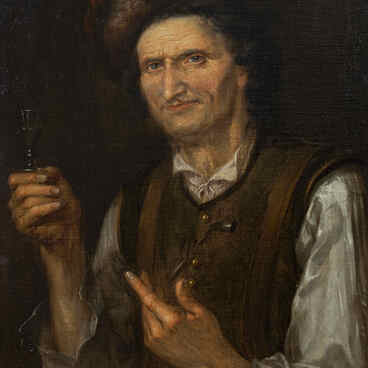Titian Vechellio, or Titian, was an Italian painter, the greatest representative of the Venetian school of the High and Late Renaissance. His name is on a par with such artists as Michelangelo, Leonardo da Vinci, and Raphael. Titian painted Biblical and mythological scenes and also excelled as a portraitist.
The painting “Rebekah at the Well” was transferred to the Far Eastern Art Museum from the Moscow Museum of Fine Arts in 1931. The painting was identified as a work of an unknown artist — a description given to it as it came from the Feitelberg Brothers’ private collection after the revolution.
In the early 1990s, the painting underwent a series of studies at the Laboratory of Scientific and Technical Expertise of the State Hermitage. After the art and technological analysis, “Rebekah at the Well” was authenticated as the painting by one of the world’s greatest masters, Titian Vechellio.
The identification process was thorough. Among other tests, a comparative analysis of the museum’s canvas with reference works by Titian was conducted. X-rays of the painting were matched with those of “The Tribute Money”, “Vanity”, “Christ Carrying the Cross”, “Penitent Magdalene”, etc. All of these radiographs show the artist’s process of working on the canvas: the positions of the characters and their size in relation to the size of the canvas changed, but the way the hands were executed remained identical.
Titian had used the composition of “Rebekah” previously as well. A similar closed structure formed by two figures could be seen in his “Dinarius of Caesar”.
The subject of this painting is very popular in Italian art. It is based on the Old Testament story of Abraham sending his faithful servant Eliezer to find a bride for his son Isaac. It is this meeting between Eliezer and Rebecca, Isaac’s future wife, that the painter captured.
Titian introduced some important iconographic details into this motif: the camel, the well, and the precious gifts. Traditionally, Eliezer is depicted in advanced years — he is the one in charge of the servants in the house of Abraham. Rebekah is dressed in the Venetian fashion of the Titian period.
The type of heroine was characteristic of many other paintings by Titian, and he repeatedly portrayed similar girls in “Madonna and Child with St. Catherine”, “Sacred and Profane Love”, and “Flora”. The model for all of them most likely was Violante, daughter of the painter Palma Vecchio, which becomes evident when comparing the above mentioned paintings with her portrait by Titian.
The painting “Rebekah at the Well” was transferred to the Far Eastern Art Museum from the Moscow Museum of Fine Arts in 1931. The painting was identified as a work of an unknown artist — a description given to it as it came from the Feitelberg Brothers’ private collection after the revolution.
In the early 1990s, the painting underwent a series of studies at the Laboratory of Scientific and Technical Expertise of the State Hermitage. After the art and technological analysis, “Rebekah at the Well” was authenticated as the painting by one of the world’s greatest masters, Titian Vechellio.
The identification process was thorough. Among other tests, a comparative analysis of the museum’s canvas with reference works by Titian was conducted. X-rays of the painting were matched with those of “The Tribute Money”, “Vanity”, “Christ Carrying the Cross”, “Penitent Magdalene”, etc. All of these radiographs show the artist’s process of working on the canvas: the positions of the characters and their size in relation to the size of the canvas changed, but the way the hands were executed remained identical.
Titian had used the composition of “Rebekah” previously as well. A similar closed structure formed by two figures could be seen in his “Dinarius of Caesar”.
The subject of this painting is very popular in Italian art. It is based on the Old Testament story of Abraham sending his faithful servant Eliezer to find a bride for his son Isaac. It is this meeting between Eliezer and Rebecca, Isaac’s future wife, that the painter captured.
Titian introduced some important iconographic details into this motif: the camel, the well, and the precious gifts. Traditionally, Eliezer is depicted in advanced years — he is the one in charge of the servants in the house of Abraham. Rebekah is dressed in the Venetian fashion of the Titian period.
The type of heroine was characteristic of many other paintings by Titian, and he repeatedly portrayed similar girls in “Madonna and Child with St. Catherine”, “Sacred and Profane Love”, and “Flora”. The model for all of them most likely was Violante, daughter of the painter Palma Vecchio, which becomes evident when comparing the above mentioned paintings with her portrait by Titian.


